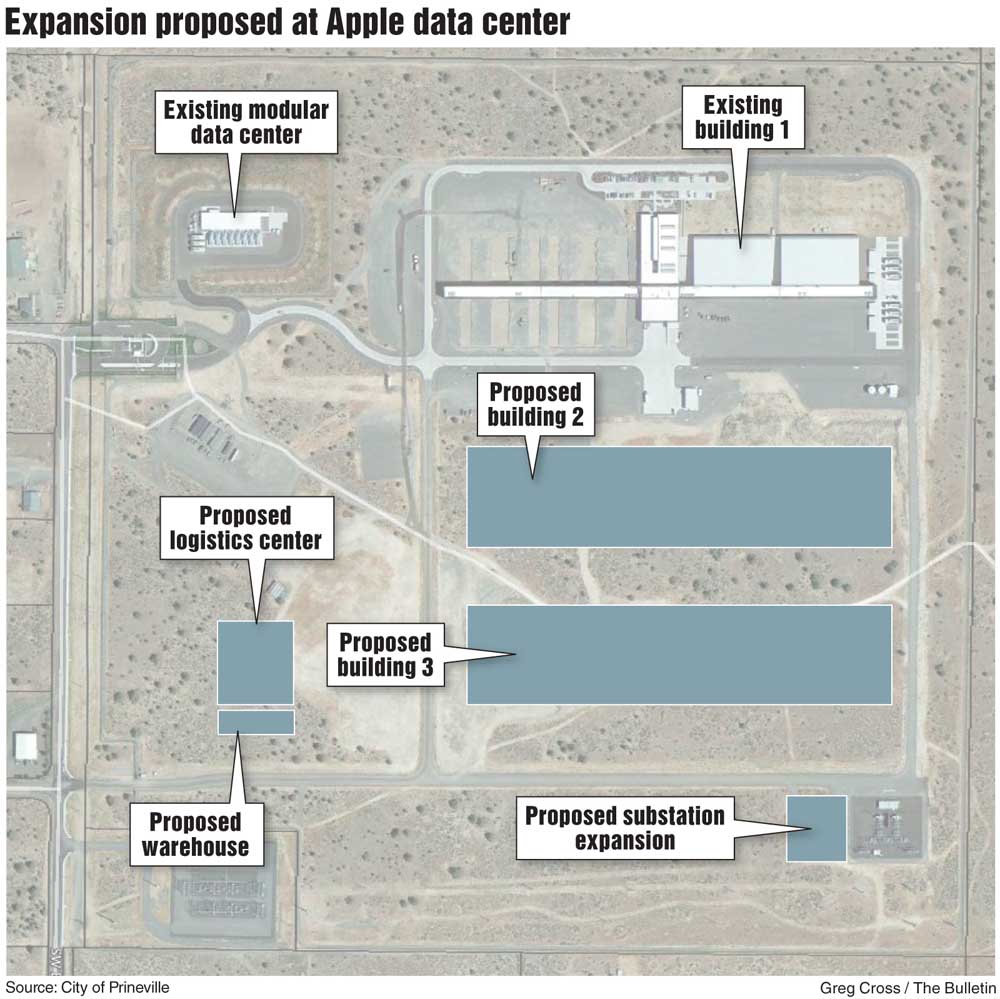Apple plans to expand Prineville data center
Published 12:00 am Friday, July 1, 2016

- Apple plans to expand Prineville data center
Apple Inc. plans to expand its Prineville data center with a third building, and construct a new logistics and distribution building and a power substation, according to plans submitted to the city.
The expansion plan comes as Apple continues construction on its second data-center building, all while planning to drastically reduce its use of the local drinking-water supply. The company has agreed to pay for a multimillion-dollar wastewater treatment plant with capacity for 5 million gallons a year, City Engineer Eric Klann said. The state-of-the-art plant will provide Apple with enough high-quality water to supply 95 percent of its evaporative cooling needs, he said.
“The city will never have to come up with a dime for this project,” Klann said. And when it’s finished, drought will no longer limit the city’s ability to support data centers. “No matter how bad a drought is, people still have to flush their toilets,” he said.
The water Apple plans to use would otherwise go to the golf course, pasture lands, or river in the winter, Klann said. The city will still supply treated wastewater to those users but will supplement it with fresh water from the Prineville Reservoir, he said.
The business needs behind Apple’s third data-center building are unknown. The company did not respond to a message from The Bulletin, and Prineville officials, who meet monthly with a local manager, are careful not to reveal the company’s secrets, Mayor Betty Roppe said.
On its original 154 acres, Apple has one 330,000-square-foot data center building, which is configured with eight pods connected along a central spine, and another building of the same size under construction. The first two buildings were approved in 2012.
The third data-center building, also 330,000 square feet, is under site-plan review, Senior Planner Josh Smith said. If Apple completes the third data-center building, the company will have about 23 acres of computer hardware under roof.
Apple’s latest expansion will include a new logistics and distribution center at the front of the campus and a power substation, Smith said.
Smith does not expect a lengthy review process. The next step will be for Apple to obtain building permits, he said.
“They generally move pretty quick once they submit,” he said.
The California tech giant also owns an additional 210 acres of undeveloped land it bought from Crook County for $3.6 million in September, according to property records.
Also home to Facebook data centers, Prineville was attractive to the industry partly because of its dry climate, Klann said. With low humidity, data centers can use energy-efficient evaporative cooling instead of air-conditioning, which hogs electricity, to keep their warehouses of servers comfy.
The drawback of evaporative cooling, which Klann described as a “high-tech swamp cooler,” is that it requires a lot of water, and if the water is high in mineral content, as it is in Central Oregon, the cooling system can recycle it only a few times before the minerals begin clogging the filters, he said.
Apple used 6.79 million gallons of Prineville’s drinking water in 2014, and Facebook used 1.3 million gallons, plus 9.2 million gallons from its own wells. With the decline of the wood-products industry, data centers are now Prineville’s biggest water users.
The wastewater treatment plant that Apple will pay for — Prineville officials would not disclose the cost — will allow the company to use the water more efficiently, Klann said.
Apple currently cycles city water through its cooling system 2.2 times, on average. The treated wastewater will be so clean and so low in mineral content that Apple expects to get six cycles out of it, he said.
Klann said he wanted to tour a similar plant but was told by engineers at CH2M Hill, which designed it, that the only other example in the world is in Australia.
Future data-center builders, or other industrial water users, will be able to tap into the system if they pay to expand the capacity and reimburse Apple for its costs, Klann said. Apple is paying not only for the treatment plant on the valley floor, on city land next to Prineville’s current treatment plant, but also for the pipeline up to the mesa, where the data center is located, he said. The treatment plant is under design and expected to be running by spring of 2018.
— Reporter: kmclaughlin@bendbulletin.com, 541-617-7860






